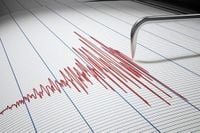On April 18, 2025, at 1:40 AM local time, residents of Matías Romero, Oaxaca, were startled by a magnitude 4.6 earthquake that struck at a depth of 141.9 kilometers. The epicenter of this seismic event was located approximately 71 kilometers northeast of Matías Romero, according to preliminary reports from the Servicio Sismológico Nacional (SSN). Though the quake was not among the most powerful recorded in Mexican history, it served as a reminder of the country's vulnerability to seismic activity.
In light of the earthquake, the Centro Nacional de Prevención de Desastres (Cenapred) has urged the public to remain vigilant and rely on official sources for information, especially in the face of potential rumors and misinformation. Residents are advised to check their homes for possible damage, limit cellphone use to emergencies, avoid lighting matches or candles until confirming there are no gas leaks, and be prepared for aftershocks.
"In the event of a quake, stay calm and move to a safe area, away from objects that could fall," a Cenapred spokesperson recommended. The agency also emphasized the importance of having an emergency plan in place, which includes conducting evacuation drills and identifying safe zones in homes, schools, and workplaces.
Mexico's geographical location makes it particularly susceptible to earthquakes. The nation has a long history of significant seismic events, with the most devastating occurring on March 28, 1787, when an earthquake measuring 8.6 struck Oaxaca, generating a tsunami that penetrated six kilometers inland. This historical context underscores the potential for catastrophic natural events in the region.
Further examining Mexico's seismic history, the earthquake of September 19, 1985, registered a magnitude of 8.2 and was centered in Guerrero. This disaster resulted in widespread destruction and a significant loss of life, prompting changes in building codes and emergency preparedness protocols across the country. The 2017 earthquake, which struck between Puebla and Morelos, also had dire consequences, claiming the lives of 369 individuals.
While the recent quake in Oaxaca was relatively moderate, it serves as a reminder of the potential for more severe seismic activity. Experts have noted that the region known as the Brecha de Guerrero holds geological data suggesting that earthquakes with magnitudes exceeding 8.6 could occur in the future. This area, located between Mexican and Central American coastlines, has a history of significant seismic activity and poses a risk for future earthquakes.
On the same day as the Matías Romero quake, several additional seismic events were recorded across Mexico. A magnitude 4 earthquake occurred 26 kilometers southwest of San Pedro Pochutla, Oaxaca, and another registered a magnitude of 4.7, located 357 kilometers southwest of Puerto Vallarta, Jalisco. Additionally, a magnitude 4 earthquake was detected 102 kilometers southeast of Salina Cruz, Oaxaca, and a magnitude 4.3 quake was reported 28 kilometers southwest of Pijijiapan, Chiapas. These events highlight the ongoing seismic activity in the region.
For those caught in an earthquake while driving, the Instituto Nacional de Prevención Sísmica (SSN) advises drivers to stop their vehicles and move to a safe location away from buildings, trees, and utility poles. If an earthquake occurs while shopping, individuals should remain calm and seek shelter under sturdy furniture or in designated safety areas within the store.
In the context of earthquakes, it is crucial to understand the terminology used to describe these events. The term "sismo" refers to any movement of the Earth's crust, regardless of intensity, while "temblor" is used for minor movements that do not cause damage. "Terremoto," on the other hand, indicates a more severe earthquake that can result in significant destruction and loss of life.
The strongest earthquake ever recorded occurred on May 22, 1960, in Valdivia, Chile, reaching a magnitude of 9.5. This catastrophic event triggered volcanic eruptions and tsunamis that devastated coastal cities and impacted regions as far away as Japan and Hawaii. It serves as a stark reminder of the destructive power of seismic forces.
As Mexico continues to grapple with its seismic reality, government agencies and local authorities are working tirelessly to enhance preparedness and response strategies. The recent earthquake serves as a crucial reminder of the importance of community awareness and individual preparedness in mitigating the risks associated with such natural disasters.
In summary, the earthquake that struck Matías Romero, Oaxaca, on April 18, 2025, is a reminder of Mexico's ongoing struggle with seismic activity. As experts continue to study the potential for future earthquakes, residents are encouraged to remain informed and prepared. By taking proactive measures, individuals can help ensure their safety and that of their communities in the face of potential seismic threats.





